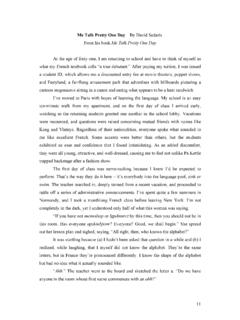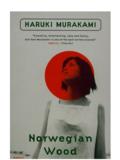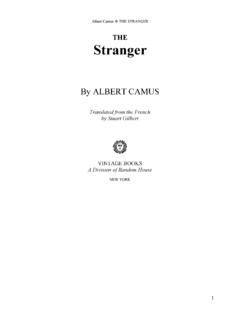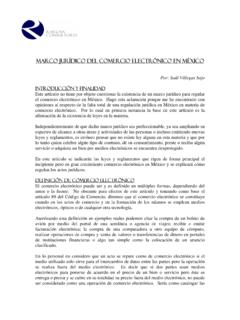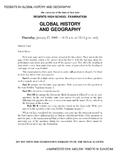Transcription of Understanding a Photograph John Berger - Marco …
1 1 Understanding a Photograph john Berger For over a century, photographers and their apologists have argued that photography deserves to be considered a fine art. It is hard to know how far the apologetics have succeeded. Certainlythevast majority of people do not consider photography an art, even whilst they practise, enjoy, use and value it. The argument of apologists (and I myself have been among them) has been a little academic. It now seems clear that photography deserves to be considered as though it werenota fine art. It looks as though photography (whatever kind of activity it may be) is going to outlive painting and sculpture as we have thought of them since the Renaissance. It now seems fortunate that few museums have had sufficient initiativeto open photographic departments, for it means that few photographs have been preserved in sacred isola tion, it means that the public have not come to think of any photographs as being beyond them.
2 (Museums function like homes of the nobility to which the public at certain hours are admitted as visitors. The class nature of the 'nobility' may vary,but as soon as a work is placed in a museum it acquires themysteryof a way of life which excludes the mass.) Let me be clear. Painting and sculpture as we know them are not dying of any stylistic disease, of anything diagnosed by the professionallyhorrified as cultural decadence; they are dying because, in the world as it is, no work of art can survive and not become a valuable property. And this implies thedeath of painting and sculpture because property, as once it was not, is now inevitably opposed to all other values. People believe in property, but in essence they only believe in the illusion of protection which property gives.
3 All works of fine art, whatever their content,whatever the sensibility of an individual spectator, must now be reckoned as no more than props for the confidence of theworld spirit of conservatism. By their nature, photographs have little or no property value because they have no rarity value. The very principle of photography is that the resulting image is not unique, but on the contrary infinitely reproducible. Thus, in twentieth century terms, photographs are records of things seen. Let us consider them nocloser to works of art than cardiograms. We shall then be freer of illusions. Our mistake has been to categorize things as art by considering certain phases of the process of creation. But logically this can make all man made objects art.
4 It is more useful to categorize artby what has become its social function. It functions as property. Accordingly, photographs are mostly outside the category. Photographs bear witness to a human choice being exercised in a given situation. A Photograph is a result of the photographer's decision that it is worth recording that this particularevent or this particular object has been seen. If everything there existed were continually being photographed, every Photograph would become meaningless. A2 Photograph celebrates neither the event itself nor the faculty of sight in itself. A Photograph isalready a message about the event it records. The urgency of this message is not entirely dependent on the urgency of the event but neither can it be entirely independent from it.
5 At its simplestthe message, decoded, means: Ihave decided that seeing this isworth recording. This is equally true of very memorable photographs and the most banal snapshots. What distinguishes the one from the other is the degree to which the Photograph explains the message, the degree to which the Photograph makes the photographer's decision transparent and comprehensible. Thus we come to little understood paradox of the Photograph . The Photograph is an automatic record through the mediation of light of a given event: yetit usesthegivenevent toexplainits recording. Photography is the process of rendering observation self conscious. We must rid ourselves of a confusion brought about by continually comparing photography with the fine arts.
6 Every handbook on photographytalks about composition. The good Photograph is thewell composed one. Yet this is true only in so far as we think of photographic images imitating painted ones. Painting, is an art of arrangement:therefore it is reasonable to demand that there is some kind of order in what is arranged. Every relation between forms in a painting is to some degree adaptable to the painter's purpose. This is not the case with photography. (Unless we include those absurd studio works in which the photographer arranges everydetail of his subject before he takes the picture.) Composition in the profound, formative sense of the word cannot enter into photography. The formal arrangement of a Photograph explains nothing.
7 The events portrayed are in themselves mysterious or explicable according to the spectator's knowledge of them prior to his seeing the Photograph . What then gives the Photograph as Photograph meaning? What makes its minimal message I havedecided that seeing this is worth recording large and vibrant? The truecontent of a Photograph is invisible, for it derives from a play, not with form, but with time. One might argue that photography is as close to music as to painting. I have said that aphotograph bears witness to a human choice being choiceis not between photographing x and y: but between photographing at x moment or at y moment. The objects recorded in any Photograph (from the most effective to the most commonplace) carry approximately the same weight, the same conviction.
8 What varies is the intensity with which we are made aware of the poles of absence and presence. Between these two poles photography finds its proper meaning. (The most popular use of the Photograph is as a memento of the absent.) A Photograph , whilst recording what has been seen, always and by its nature refers to what is not seen. It isolates, preserves and presents a moment taken from a continuum. The power of a painting depends upon its internal references. Its reference to the3 natural world beyond the limits of the painted surface is never direct; it deals in equivalents. Or, to put it another way: painting interprets the world, translating it into its own language. But photography has no language of its own. One learns to read photographs as one learns to read footprints or cardiograms.
9 Thelanguage in which photography deals is the language of events. All its references are external to itself. Hence the continuum. A movie director can manipulate time as a painter can manipulate the confluence of the events he depicts. Not so the still photographer. The only decision he can take is as regards the moment he chooses to isolate. Yet this apparent limitation givesthe Photograph its unique it shows invokes what is not shown. One can look at any Photograph to appreciate the truth of this. The immediate relation between what is present and what is absent is particular to each Photograph : it may be that of ice to sun, of grief to a tragedy, of a smile to a pleasure, of a body to love, of a winning race horse to the race it has run.
10 A Photograph is effective when the chosen moment which it records contains a quantum of truth which is generally applicable, which is as revealing about what is absent from the Photograph as about what is present in it. The nature of this quantum of truth, and the ways in which it can be discerned, vary greatly. It may be found in an expression, an action, a juxtaposition, a visual ambiguity, a configuration. Nor can this truth ever be independent of the spectator. For the man with a Polyfoto of his girl in his pocket, the quantum of truth in an 'impersonal' Photograph must still depend upon the general categories already in the spectator's mind. All this may seem close to the old principle of art transforming the particular into the universal.
